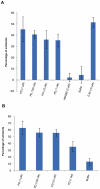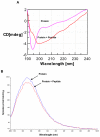Inhibitory potential of prodomain of Plasmodium falciparum protease serine repeat antigen 5 for asexual blood stages of parasite
- PMID: 22291957
- PMCID: PMC3265493
- DOI: 10.1371/journal.pone.0030452
Inhibitory potential of prodomain of Plasmodium falciparum protease serine repeat antigen 5 for asexual blood stages of parasite
Abstract
Plasmodium falciparum serine repeat antigen 5 (SERA5) is a target for both drug and vaccine intervention against malaria. SERA5 is secreted in the parasitophorous vacuole where it is proteolytically processed before schizont rupture. Among the processed products is a 50.8-kDa central domain of the protease, which possesses chymotrypsin-like activity and consists of a 28.9-kDa catalytic domain with a 21.9-kDa N-terminal prodomain, which remain attached together. Because SERA5 has been implicated in merozoite egress from host erythrocytes, the effect of the prodomain and a heptapeptide derived from its C-terminus spanning from D(560) to F(566) (DNSDNMF) on parasite growth was studied. When E. coli-expressed prodomain was incubated with parasite culture, a significant delay in transition from schizont to ring stages was observed up to nanomolar concentrations. The peptide, DNSDNMF also showed similar effects but at nearly 1000-fold higher concentrations. The peptide was also found to interact with the catalytic domain. These data demonstrate the crucial role of SERA5 prodomain for the egress process. Given the inhibitory potential of the prodomain for the parasite, we suggest that peptidomimetic inhibitors based on SERA5 prodomain sequences can be developed as future therapeutics against malaria.
Conflict of interest statement
Figures





References
-
- Delplace P, Fortier B, Tronchin G, Dubremetz JF, Vernes A. Localization, biosynthesis, processing and isolation of a major 126 kDa antigen of the parasitophorous vacuole of Plasmodium falciparum. Mol Biochem Parasitol. 1987;23:193–201. - PubMed
-
- Bzik DJ, Li WB, Horii T, Inselburg J. Amino acid sequence of the serine-repeat antigen (SERA) of Plasmodium falciparum determined from cloned cDNA. Mol Biochem Parasitol. 1988;30:279–288. - PubMed
-
- Knapp B, Hundt E, Nau U, Kupper HA. Molecular cloning, genomic structure and localization in a blood stage antigen of Plasmodium falciparum characterized by a serine stretch. Mol Biochem Parasitol. 1989;32:73–83. - PubMed
-
- Hodder AN, Drew DR, Epa VC, Delorenzi M, Bourgon R, et al. Enzymic, phylogenetic, and structural characterization of the unusual papain-like protease domain of Plasmodium falciparum SERA5. J Biol Chem. 2003;278:48169–48177. - PubMed
Publication types
MeSH terms
Substances
Grants and funding
LinkOut - more resources
Full Text Sources

